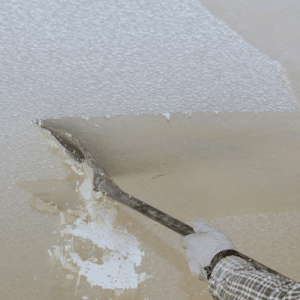Asbestos and Older Homes, What You Should Know!
 As previously discussed, asbestos in building materials is a serious health hazard for occupants of said structure if damaged or disturbed during removal of structural components. When residential construction products made with asbestos, a mineral composed of thin fibers, are damaged, those fibers become airborne. Asbestos fibers pose a danger to anyone who inhales them. Numerous cancers are associated with asbestos including Mesothelioma, Ovarian cancer and lung cancer.
As previously discussed, asbestos in building materials is a serious health hazard for occupants of said structure if damaged or disturbed during removal of structural components. When residential construction products made with asbestos, a mineral composed of thin fibers, are damaged, those fibers become airborne. Asbestos fibers pose a danger to anyone who inhales them. Numerous cancers are associated with asbestos including Mesothelioma, Ovarian cancer and lung cancer.
The list of building products that contained asbestos prior to the 1980’s is overwhelming as almost all building materials had some form of asbestos added as it was known as a strengthening agent, helping to solidify an installed component. Some of the prominent building materials that contained asbestos include:
- Asphalt roofing tiles and felt underlayment/ Asbestos siding shingles (Fiber Cement)
- Window Putty and sealants
- Vermiculite and Batt insulation
- Wallpaper/ Drywall/ Plaster and Spackle
- HVAC ductwork and insulation wrap/ Heat source coverings
- Popcorn sprayed ceilings/ Textured paint
- Vinyl flooring adhesives and underlayments
- Recessed lighting/ Wiring insulation/ Outlets/ Fuse boxes
- Appliances including Refrigerators/ Range hoods/ Clothes dryers
The list goes on with numerous smaller components as well. The bottom line to know is that asbestos is not dangerous unless damaged or disturbed. For example, a popcorn ceiling that contains asbestos would not pose a health risk unless its finish was damaged or peeling. As remodeling an older property is a common practice, removal of building materials should be done with a certain remediation protocol in place to protect those involved with the removal from health risks associated with asbestos fibers. Common exposure scenarios include:
- Drilling into asbestos in drywall or plaster. A common practice by a homeowner as we hang pictures and wall decorations.
- Attic renovation. Older and original vermiculite or batt insulation is still common to see and has a high probability of having asbestos. Proper removal by a professional is strongly recommended.
- Removing vinyl floor tiles or linoleum. Asbestos was a common ingredient in vinyl floor tiles and adhesives through the 1950’s and 1960’s.
- Popcorn ceiling removal. Scraping the popcorn ceiling finish off of the wallboard with out proper remediation techniques can pose a serious health risk from exposure to airborne asbestos fibers.
- Brake dust in home garage. Because some brake components contain asbestos, spraying them with compressed air or blowing off surface dust can create airborne asbestos fibers.
What is the best way to protect yourself from asbestos you ask?
The Do’s:
- Avoid any contact with dangerous asbestos materials.
- Take every precaution not to damage any materials that may contain asbestos.
- Talk to your home inspector or real estate agent about any known asbestos risks in your home.
- Only hire trained professionals for asbestos inspections, testing, repairs or removal.
- If you are planning on a demolition, contact the appropriate regulatory agency in your local or state government.
The Dont’s:
- Don’t sweep, vacuum or dust debris that may contain asbestos.
- Don’t collect asbestos samples for testing without proper training.
- Don’t perform any work on or near asbestos materials unless you’re trained and certified.
- Don’t remove asbestos unless repair or concealment is impossible, and there’s a high risk for exposure.
- Don’t dispose of asbestos materials with normal household waste.
- Don’t saw, sand, scrape, drill or disturb materials that may contain asbestos.
Asbestos in older homes? You betcha!! Our home inspection teams are prepared to protect and educate you with asbestos risks and other things in the new home you are purchasing or the current home that you live in. Call us today for free consultation.
Thank you for clicking in to our blog, we hope that the experience was educational and helpful for you.
